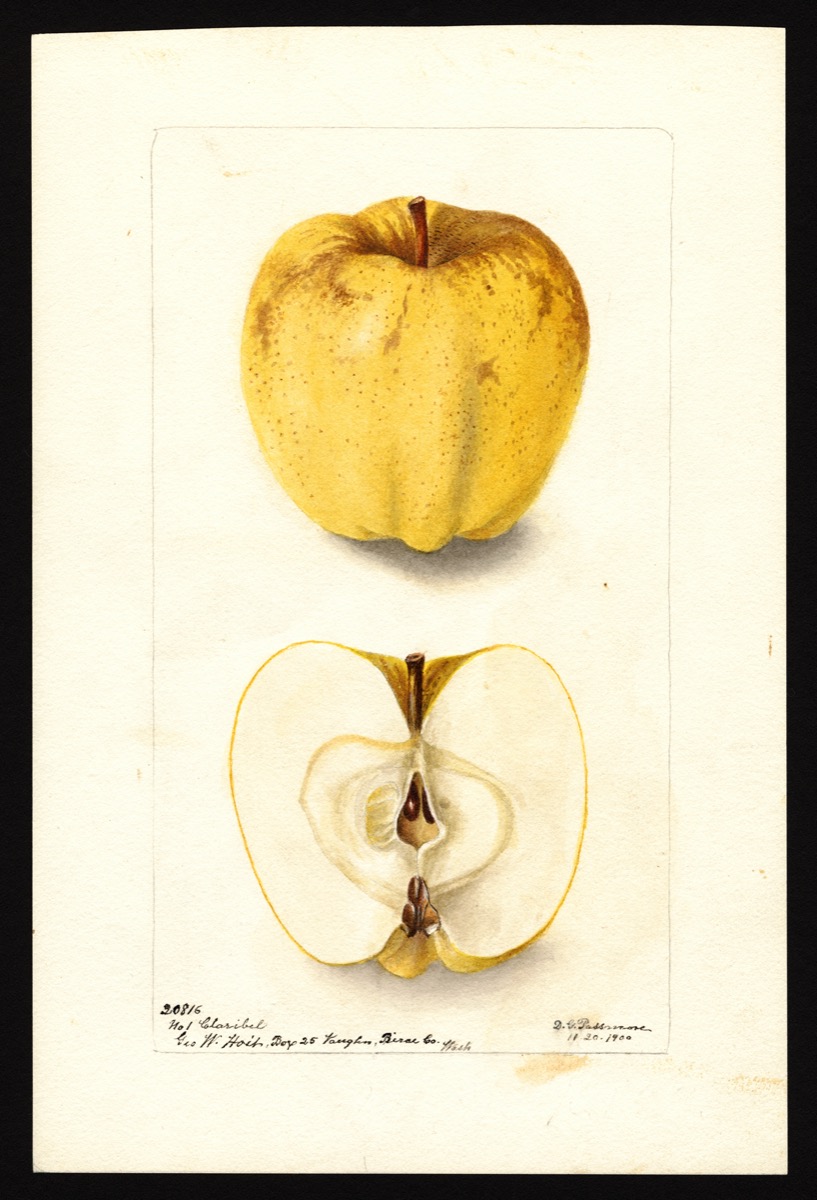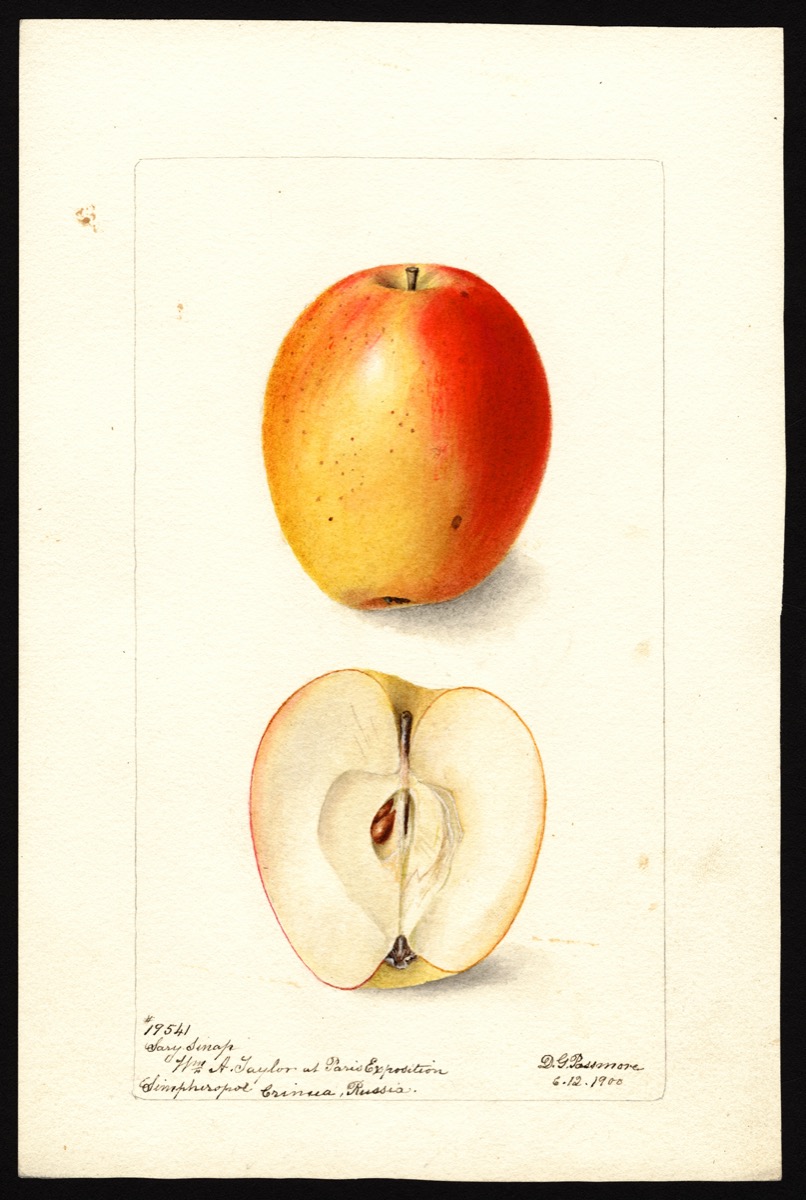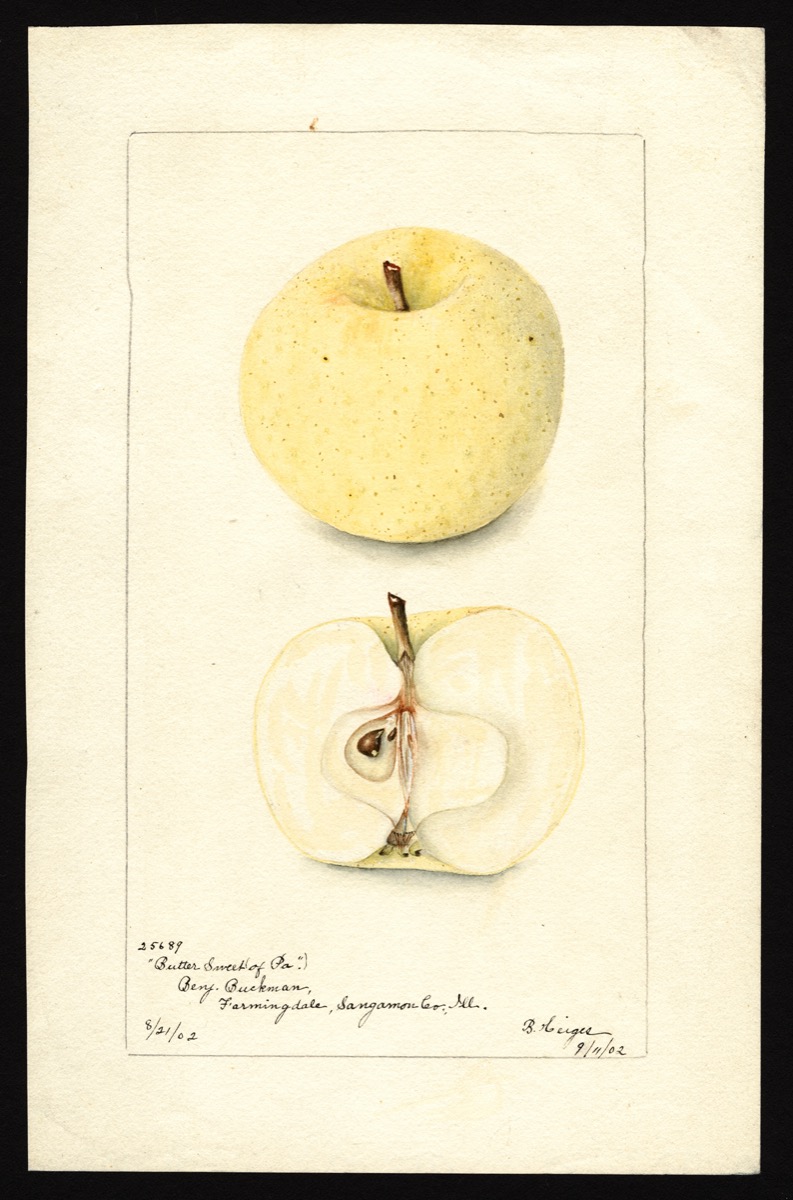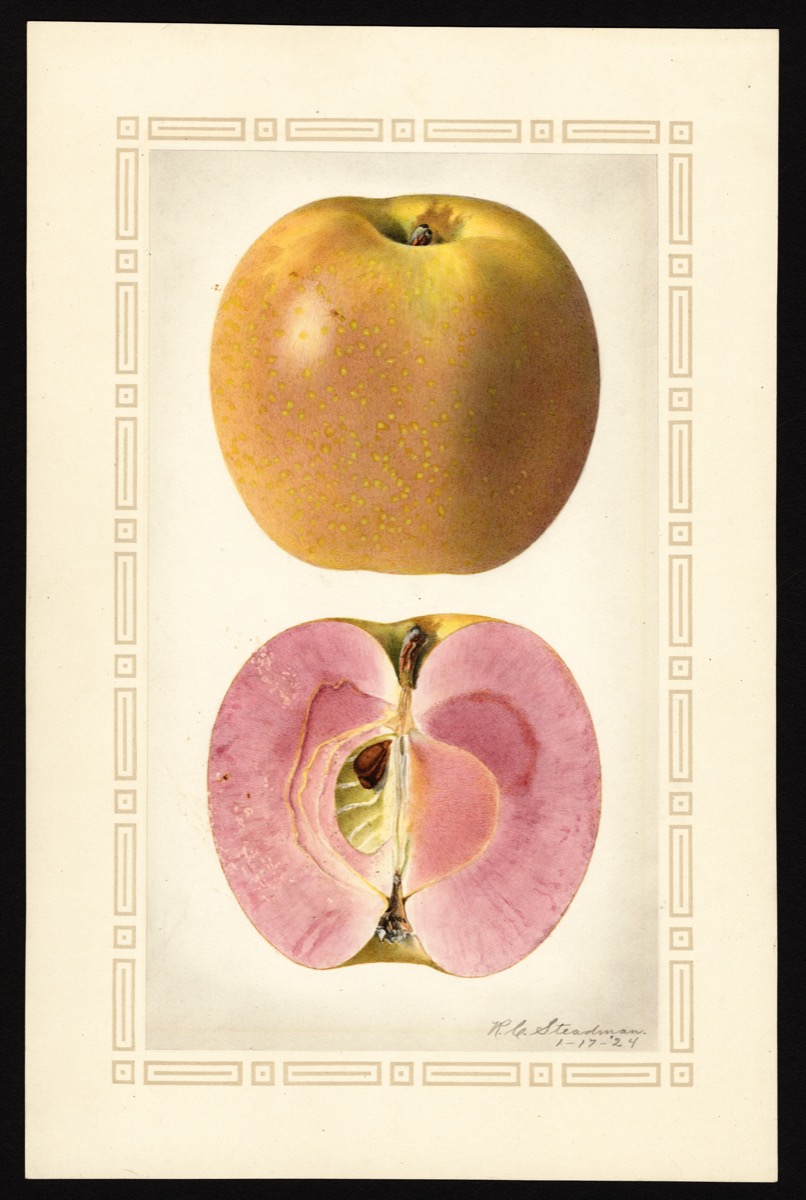The Malus Domestica Detectives
15:12 minutes

Apples have been an important staple of the American diet for centuries, thanks to their hardiness and delicious taste. North America once had 17,000 varieties of domesticated apples, but only about a third still exist today. Across the U.S., volunteer apple detectives are now searching for these lost apple varieties, often on abandoned pioneer-era orchards.
Earlier this month, the Lost Apple Project in Washington state announced a fruitful bounty: Ten varieties of apples found in the Pacific Northwest that had been considered “lost” varieties. These include the Sary Sinap, originally from Turkey, and the Streaked Pippin from New York.
To find these varieties, the researchers used an old school identification process—the partner organization, Temperate Orchard Conservancy, compared the mystery apples to watercolor paintings commissioned by the USDA from the 1800s and early 1900s. It’s a time consuming process, and positive identification can take years.
Joining Ira to talk apple identification are Shaun Shepherd, pomologist at the Temperate Orchard Conservancy in Portland, Oregon, and Gayle Volk, plant physiologist at the USDA in Fort Collins, Colorado.
Below, you can see the USDA’s watercolor paintings for the Sary Sinap of Turkey, Butter Sweet of Pennsylvania, and Claribel of Washington, and more! These paintings are still used today by apple detectives like Shaun Shepherd.




Invest in quality science journalism by making a donation to Science Friday.
Shaun Shepherd is a pomologist with the Temperate Orchard Conservancy in Portland, Oregon.
Gayle Volk is a research plant physiologist at the USDA Agricultural Research Service based in Fort Collins, Colorado.
IRA FLATOW: This is Science Friday. I’m Ira Flatow. Just one quick note, we’re trying to figure out why people do citizen science or don’t. And this means it’s research time, so please help us out at sciencefriday.com/citizenscience.
When you think about apples, don’t you consider them to be a very American fruit, you know, apple pie? Well, maybe that’s because North America once had 17,000 varieties of domesticated apples, yet only about a third of those still exist. So where did they all go? Across the US, volunteer apple detectives are searching for those lost apple varieties.
The Lost Apple Project in Washington state recently made a big announcement. They rediscovered 10 types of apples in the Pacific Northwest, some with faraway origins. Here with us to talk about identifying lost apples are Shaun Shepherd, a pomologist at the Temperate Orchard Conservancy in Portland, Oregon, and Gayle Volk, plant physiologist for the USDA in Fort Collins, Colorado.
Welcome both of you to Science Friday.
SHAUN SHEPHERD: Good morning, Ira.
GAYLE VOLK: Thank you.
IRA FLATOW: Nice to have you. How did such a variety of apples get to the Pacific Northwest, Shaun?
SHAUN SHEPHERD: Well, there were a lot of mail order nurseries that sent stuff all over the country. And there were people that collected vast assortments of varieties and spread them out. There was a man in Illinois named Benjamin Buckman that had 600 or 800 varieties, which he sent out to people that wanted to get different ones to graft and collect them.
IRA FLATOW: Was there ever really a Johnny Appleseed? Was that guy, perhaps, Johnny Appleseed?
SHAUN SHEPHERD: He was close. He disseminated a whole lot of stuff to a whole lot of people, apparently.
IRA FLATOW: Well, if we had so many of them, how do you lose so many varieties of apples?
SHAUN SHEPHERD: Well, mostly people just forget what they are. You’ve got a homesteader plants an orchard and, for whatever reason, they quit, and they leave the property. The people that come next may not necessarily know what they are or there’s no people there.
So you have these trees just standing there for 100 years growing. They’re still what they were to start with, it’s just nobody knows what they are. We think that a great many of the varieties that are lost are simply lost. They’re out there growing someplace, but we just don’t know. Somebody has to figure out what they are.
IRA FLATOW: So you mean they could be in somebody’s backyard now when they bought a house with a tree in it and not even know it’s one of these abandoned apple trees?
SHAUN SHEPHERD: Yes, definitely.
IRA FLATOW: Wow. Do we know why, then, that apples were the fruit of choice for these homesteaders?
SHAUN SHEPHERD: Well, you can eat them. You can feed them to cattle. You can press them into apple juice and ferment hard cider, and you can distill that into brandy. It’s a very useful fruit.
IRA FLATOW: I know you identified these rediscovered apples for the Lost Apple Project. Give us a couple of examples of the types of apples you found and what you learned about their origins.
SHAUN SHEPHERD: Well, one of them was the Sary Sinap. And it turns out it was brought from Turkey, or that’s where its origins are. There were a lot of apples brought by different horticultural societies across the United States at different times. This may have been in a batch brought by the Michigan State Horticultural Society in the 1880s.
IRA FLATOW: So they really came in from all across America?
SHAUN SHEPHERD: Well, all across the world. There’s a lot of Russian apples here too.
IRA FLATOW: So people brought them with them as immigrants and planted them?
SHAUN SHEPHERD: Well, no. These were imported on purpose by people who were interested in more strains of apples. They were interested in growing a lot of different things and seeing what would succeed, and they imported them because we didn’t have them here already.
IRA FLATOW: That’s interesting. So as you are working through the Lost Apple Project, you must find an apple you haven’t seen before and take a bite out of it. But what do they taste like?
SHAUN SHEPHERD: Apples have a huge variety of flavors, from saccharin sweet or candy-like to as sour as a lemon. There’s a vast array of flavors. We found one that tastes like mint. We’ve never seen it in the literature. We haven’t figured out what it is. But minty, it blew our minds when we tasted it.
IRA FLATOW: Wow. And you used watercolor paintings to help identify them. I find this so fascinating. How does that work?
SHAUN SHEPHERD: Well, between about 1880 and 1939, the USDA employed watercolorists to document apples, and they did true-to-life watercolors of apples that people sent in. So there exist about 6,000 of these paintings of apples. And some varieties have more than one, some only have one.
Some apples are only represented in literature by the watercolor. But apples vary hugely. I mean, they come in all different colors, and shapes, and sizes, and they ripen at different time. But if you find it– if you look at an apple and it looks like so-and-so– anyway, sometimes we can find his exact duplicate in these watercolors.
IRA FLATOW: And how reliable, then, is that method? You say sometimes. Don’t a lot of apples look alike? I mean, you–
SHAUN SHEPHERD: Yes, that’s true.
IRA FLATOW: These watercolors must have been painted very accurately.
SHAUN SHEPHERD: They are very accurate. In fact, they’re probably– well, they’re more accurate than a photograph, in some ways. But we have to also search the literature.
There were a lot of pomologists in the 19th century that wrote very detailed descriptions of these apples, all their characteristics. Without the detailed descriptions, it’s much more difficult to just go by a picture. Once in a while we can do it, but it has to be a really unique looking apple.
IRA FLATOW: So you’re talking about a process that can take years–
SHAUN SHEPHERD: Yes.
IRA FLATOW: –to bear fruit, so to speak?
SHAUN SHEPHERD: Yes, there’s been apples it took me years to figure out what they were.
IRA FLATOW: Hmm. Gayle, the USDA uses a different method, right, to identify apples and other plants? Tell us about how that works.
GAYLE VOLK: Well, USDA has a national collection of apple cultivars and wild species in upstate New York, and we’ve been using genetic testing to look at the DNA and identify or fingerprint all these varieties in our national collection based on the DNA fingerprints.
IRA FLATOW: And I guess DNA fingerprinting is a much more reliable method than watercolors.
GAYLE VOLK: It’s a genetic test. It’s based on the data of the DNA.
IRA FLATOW: But you have to have the source of the genetic material in your lab, right, to compare it to?
GAYLE VOLK: Right. We need to have those varieties available in our national collection. And then they serve as references for these varieties that could be found on historical lands.
IRA FLATOW: OK, I’ll bite. How many apple varieties can the USDA identify right now?
GAYLE VOLK: Well, we have about 2,500 trees in our permanent collection that are mostly domesticated cultivars. And I use about 1,200 of those in our genetic analysis.
IRA FLATOW: So when you say they’re cultivars, the USDA is actually growing the apple trees?
GAYLE VOLK: Yes. We have a field collection of apple trees in Geneva, New York, and it’s part of our national gene bank system.
IRA FLATOW: What do you do with all the apples?
GAYLE VOLK: Oh, the trees aren’t grown necessarily for their apples. Sometimes they’re sent off for researchers for projects. But usually the materials in the collection are used for evaluation trials, therefore genetic research. And they’re also for distribution for research purposes.
IRA FLATOW: So they’re not mature trees that are bearing fruit yet?
GAYLE VOLK: Oh, most of them do bear fruit. Absolutely.
IRA FLATOW: Oh, I can’t imagine not having some of the fruits from those apples, but that’s me. I know the USDA has a large collection of seasoned plant materials in Fort Collins, where you are, including for the apples here. What is this collection for, the whole collection, why do you have that?
GAYLE VOLK: Well, USDA has a collection that’s maintained. It’s called the National Plant Germplasm Systems Collection, and it’s about 600,000 different accessions of crop plants that are important to American agriculture. So we maintain this as a distributed collection at around 20 different locations in the country, and we make them available for breeders and for researchers for plant improvement, primarily.
Our facility here in Fort Collins, Colorado, has about 530,000 accessions stored, mostly as seeds. But we also have things placed into liquid nitrogen as other plant forms as well. We’ve got over 2,000 apple cultivars stored in liquid nitrogen as dormant buds.
IRA FLATOW: Wow. I remember years ago when we first started talking about apples. And something I didn’t know is that if you eat an apple and you take the seed and you plant it, you’re not going to get the same apple from that seed, are you?
GAYLE VOLK: No. Apples are grafted. That means they’re vegetatively propagated. And the original apple tree for a given cultivar has been multiplied many, many times through a grafting process.
IRA FLATOW: Does this complicate it all, then, the DNA testing methodology?
GAYLE VOLK: Actually, it simplifies it because every Red Delicious apple in the country has the exact same genetic signature.
IRA FLATOW: Is that right?
GAYLE VOLK: Yes.
IRA FLATOW: So is that sort of a dangerous thing, then, if there’s a blight that wipes out one kind of apple, like we’re seeing with bananas going on now, it could just spread across the country?
GAYLE VOLK: It’s certainly a possibility. The different varieties of apple do have some different genetic compositions, so there is some resistance built in. And that’s a big effort for some of the breeding programs in the country, to bring in new sources of resistance to possible future threats.
IRA FLATOW: I hear that you’re part of a research team that’s looking at potentially lost apples in Yosemite National Park. Why there? What can you tell us about this project?
GAYLE VOLK: We’re working with Yosemite National Park to help them understand what kinds of apple trees they have in 10 old heritage orchards that were planted between the 1850s and the 1890s in the park. We’ve tested over 361 trees that are currently in Yosemite, and helped them understand what varieties they have and which trees could be targeted for future protection efforts.
IRA FLATOW: Shaun, do you ever leave the Portland area and go, like, to Yosemite to look for some apple trees?
SHAUN SHEPHERD: That’d be great. We’ve gone all over the state of Oregon and different places in Washington looking at orchards here and there.
IRA FLATOW: You know, it’s interesting about apples and apple preservation conservation between both of you because you don’t hear about this level of excitement for rediscovering variety of other fruits or vegetables. What do you think it is about apples, Gayle and Shaun, that gets people so impassioned?
SHAUN SHEPHERD: Well, apples are the quintessential American fruit. There are a huge number of varieties, and over time interest is building and has been building for the last 50 years. There’s been different individuals that have been doing some of this work. And partly it’s due to efforts to publicize this effort.
IRA FLATOW: Are there other pomologists, and I think– I guess the word pomologist, Latin, pom, fruit, right?
SHAUN SHEPHERD: Yes.
IRA FLATOW: Are they also working across the country or in other countries to discover apples, orphan apples like you are?
SHAUN SHEPHERD: Yes, there are people all over the world doing the same thing. We have some friends in Great Britain that are very interested in this sort of thing.
IRA FLATOW: I’m Ira Flatow, and this is Science Friday from WNYC Studios, talking with a couple of apple specialists, Shaun Shepherd, a pomologist at the Temperate Orchard Conservancy in Portland, Oregon, and Gayle Volk, plant physiologist for the USDA in Fort Collins, Colorado. Do you ever have a– do you ever go to an art museum or talk to art conservatory people and say, hey, look, if you ever come up with a painting that has apples in it, wherever it is, I want to see it?
SHAUN SHEPHERD: Yes, I take special note of apples in paintings. I was in Rome a couple years ago and was like, oh, look at that. That’s the same apple in that painting and that painting over there. And eventually I figured out what it was.
IRA FLATOW: You probably drew a crowd of people, I think, too when you were doing that.
SHAUN SHEPHERD: Nobody noticed.
IRA FLATOW: Well, what would you like to do, if you had resources, Shaun, to expand what you were doing, and if I could give you a blank check and say, hey, here’s some money to collect some more information, what would you do with it?
SHAUN SHEPHERD: Partly what needs to be done is the purpose of the Temperate Orchard Conservancy was to reproduce Nick Botner’s collection of 4,500 varieties. We probably have 3,500 to 4,000 varieties in our collection now. What needs to be done is we need to try to verify that the names on those are correct because we know that many of them are wrong.
We know that some of them are wrong in the Geneva collection that Gayle’s referred to. So that’s one of the main things that needs to be done. We also need to have a clearinghouse of information about what varieties exist and where. It’s very difficult to figure out whether an actual apple is actually known to exist or not because there– you can check several major lists, but there’s a lot of collections all over the country that nobody knows what’s in there.
IRA FLATOW: Well, maybe you’ll hear from them after we broadcast, and hopefully you’ll get some information and some great back-feed. I want to thank both of you for taking time to be with us today. Shaun Shepherd, a pomologist at the Temperate Orchard Conservancy in Portland, Oregon, and Gayle Volk, plant physiologist for the USDA in Fort Collins. Thank you both for being with us today.
GAYLE VOLK: Thank you, Ira.
SHAUN SHEPHERD: Thank you, Ira.
IRA FLATOW: You’re welcome. Want to learn more about the lost apples rediscovered by the Lost Apple Project? Go over to our website ScienceFriday.com. There you can look at the USDA’s watercolor paintings for the Sary Sinap of Turkey, the Butter Sweet of Pennsylvania, and Claribel of Washington. These are the paintings still used today by apple detectives like Shaun Shepherd. Check them out. They’re really beautiful.
Copyright © 2020 Science Friday Initiative. All rights reserved. Science Friday transcripts are produced on a tight deadline by 3Play Media. Fidelity to the original aired/published audio or video file might vary, and text might be updated or amended in the future. For the authoritative record of Science Friday’s programming, please visit the original aired/published recording. For terms of use and more information, visit our policies pages at http://www.sciencefriday.com/about/policies/
Kathleen Davis is a producer and fill-in host at Science Friday, which means she spends her weeks researching, writing, editing, and sometimes talking into a microphone. She’s always eager to talk about freshwater lakes and Coney Island diners.
Ira Flatow is the founder and host of Science Friday. His green thumb has revived many an office plant at death’s door.